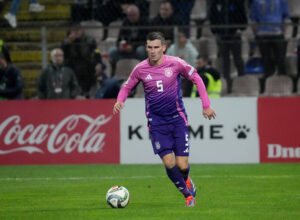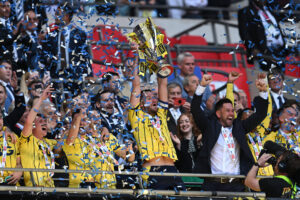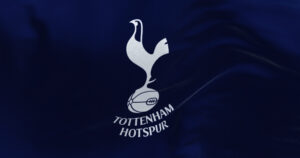Few players in the history of football can ever have endured as wretched a month as the one that Mohamed Salah has just experienced. Less than four weeks ago, Salah was dreaming of ending his magnificent first season with Liverpool by winning the Champions League Final against Real Madrid, before spearheading Egypt’s long-overdue return to the World Cup finals. Of course, fate and Sergio Ramos decreed that neither of Salah’s footballing dreams would be fulfilled.
Mohamed Salah Can Still Be A Superstar
First, Ramos showed that he is a Claudio Gentile for the 21st century by adeptly (or, as Ramos continues to maintain, accidentally) ensuring that he would not be the only player to take a tumble during the Champions League final. Whether Ramos meant to injure Salah or not is now the most moot of points, as the end result was that Salah limped out of the Kiev showpiece, taking Liverpool’s hopes and main attacking threat with him.
Then, largely because he could not train properly in the weeks leading up to the World Cup finals while his shoulder injury healed, Salah was unable to perform at anywhere near his true level in Russia. He sat out Egypt’s first game against Uruguay and although he was able to take the field against the host nation in Egypt’s second game, it was apparent from the start that he was nowhere near full fitness. He may have scored Egypt’s penalty against Russia, but otherwise he was almost as anonymous as his team-mates, as Egypt became the first nation to exit the 2018 finals. For a country that had not reached the World Cup finals in nearly thirty years (Egypt last reached the finals in 1990), Russia 2018 has been an abruptly truncated tournament.
Salah is Not Alone
In recent times, only one other player has experienced a similarly devastating month for both his club and country. That was Thierry Henry in May/June 2006. First, he made a losing Champions League Final appearance for Arsenal against Barcelona (a result that he could have altered if he had taken the one second-half chance that Arsenal’s 10 men manufactured against the Catalans). Then he made a losing World Cup Final appearance for France against Italy (after Zinedine Zidane’s moment of madness against Marco Materazzi).
However, it is arguable that Salah’s misfortune in 2018 has been even greater than that of Henry in 2006, for two reasons: first, Henry at least made the World Cup Final with France, whereas Egypt have crashed out of the World Cup in Russia in the first round; and, secondly, France regularly qualify for World Cups, whereas Egypt may never appear again at a World Cup finals during Salah’s career.
To take that view, though, is probably to be too pessimistic, because the major advantage that Salah in 2018 has over Henry in 2006 is his relative youth. Henry was nearly 29 (and arguably already past his best as a player) when he experienced his double failure, whereas Salah is still only 26 (and is arguably yet to hit his peak).
Nevertheless, the misery that Salah has experienced in the last month for both club and country will only add to the major question mark that surrounds him. That question mark is whether last season was a remarkable one-off or the start of a period of sustained brilliance.
Against the Odds
When Jurgen Klopp signed Salah for Liverpool from Roma last summer, not even he could have anticipated the record-breaking season that the Egyptian would have at Anfield. After all, Salah had already been a relative failure in England with Chelsea, where he was unable to establish himself as a first-team regular. Also, wherever he had been in his career (from his formative years in Egypt to his time in Italy, first with Fiorentina and then with Roma) he had never been a serial goal-scorer. Having proved himself to be precisely that with Liverpool last season, the challenge he now faces is to repeat (or at least come close to repeating) his record-breaking season.
There are reasons for Salah (and Liverpool fans) to be optimistic that he can enjoy a sustained period of success at club level. First, Egypt’s early exit from the World Cup at least means that he has time to recover fully from his shoulder injury before beginning pre-season training. Secondly, although Liverpool ultimately finished last season empty-handed, such was their progression throughout it that they are likely to be Manchester City’s main contenders for the Premier League title next season.
There is one other reason why Salah’s miserable end to the 2017-18 season can be the prelude to a successful campaign in 2018-19, at least at club level. That is because Liverpool are one of the few clubs in Europe and probably the only one in England for whom winning the Champions League is not as great a target as winning their domestic league. After all, even relatively youthful Liverpool fans have seen their club win the Champions League (and in the grandest of style) in Istanbul in 2005. By contrast, it is now nearly thirty years since Liverpool won the English title. (They last did so in 1990, when Egypt last qualified for the World Cup Finals.)
That means that rather than becoming fixated on the loss of the Champions League Final to Real Madrid, Salah can immediately turn his attention to winning what for many Liverpool fans is an even greater prize – the Premier League, which the club have never won. They may have won the old First Division title 18 times, but since the formation of the Premier League in 1992 the best they have achieved is a couple of runners-up spots (in 2002 and 2009).
International Optimism
There is also reason for Salah to be optimistic on the international front. Although there is no guarantee that Egypt will again qualify for a World Cup Finals while Salah is still playing, there is every chance that they will at least qualify for the next African Cup of Nations, which will be held in Cameroon early next year. And as Egypt have won their continental title a record seven times, there is every reason to be optimistic that they can go far again in Cameroon.
Even more importantly, however, Salah now has a unique opportunity to establish himself not only as the best player in the world but as the first player from the developing world to attain that status for a sustained period of time. The two modern-day greats, Cristiano Ronaldo and Lionel Messi, cannot go on forever (they are already almost certainly past their peak). Salah, who is seven and four years younger than them respectively, is probably the player with the best chance of replacing them at the top of the world game.
If he can do that, and if he can continue to remain at the game’s summit for more than a season or two, he will become the first footballer from what is now known as ‘the developing world’ to do so. In the 150-year history of professional football, the players who have come to be regarded as the best in the world have almost all come from the two traditional soccer superpowers: Europe and South America. From Uruguay’s José Andrade and Austria’s Matthias Sindelar in the 1930s to Messi and Ronaldo today, all of the greatest players in the world have been either Latin American or European, with just two exceptions.
The first was Eusebio, who was born in Mozambique but represented Portugal on the international stage, and the second was Liberia’s George Weah, who, for a brief period in the mid-1990s, was arguably the best player in the world (and unarguably the best striker). However, even those two greats did not remain at the absolute peak of their powers for more than a couple of seasons.
That is the challenge that lies ahead for Salah: to become the best player in the world; and to remain the best player in the world for more than a season or two. If he can do that (and obviously it is the biggest of “ifs”), then his place in football history will be secured forever and his month of misery in 2018 will ultimately be forgotten.
Main Photo






